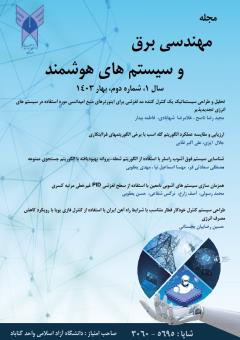طراحی سیستم کنترل خودکار قطار متناسب با شرایط راه¬آهن ایران با استفاده از کنترل فازی پویا با رویکرد کاهش مصرف انرژی
محورهای موضوعی : مهندسی برق ( الکترونیک، مخابرات، قدرت، کنترل)
1 -
کلید واژه: قطار, هوشمند, فازی,
چکیده مقاله :
افزایش ترافیک خطوط ریلی و نیاز به سرعتهاي بالاتر، وظیفه راهبران قطار را بیش از پیش سنگین نموده است. عواملی از قبیل کاهش سوانح و افزایش ایمنی، رعایت معیارهاي راحتی مسافر، بهینهسازي و مدیریت مصرف انرژي، سیستم کنترل و سیگنالینگ سنتی و مبتنی بر راهبر را وادار به حرکت به سمت سیستمهاي کنترل خودکار قطار ) ATC 1 نموده ) است. حدود یک دهه است که در کشور ما نیز ناوگان ریلی به سیستم ATC مجهز گردیده است. در این مقاله هدف طراحی یک سیستم ATC متناسب با شرایط راهآهن ایران با استفاده از منطق فازي است. به همین منظور، ابتدا با دید حل مساله بصورت ریاضی و شبیهسازي، مدل یک لکوموتیو با متغیرهاي لکوموتیو ER24PC بیان گردیده است. اطلاعات سرعت قطارهاي مسافري که در حد فاصل ایستگاههاي مشهد تا کاشمر تردد دارند از طریق الگوي سیر راهبران منتخب استخراج شده تا راحتی سفر تضمین گردد. به منظور کنترل خودکار قطار که شامل سه مرحله شتابگیري، خلاص و ترمزگیري است؛ کنترل کننده فازي پیشنهاد گردیده است. هدف این کنترل کننده ردیابی مطلوب منحنی سرعت و کاهش مصرف انرژي است که از این نظر کارایی آن با یک کنترلکننده مرسوم PI مقایسه گردیده است. بهعنوان یک راهکار نوین، از متغیرهاي جرم و درصد وزنی ترمز لکوموتیو بعنوان پسفیلتر فازي و همچنین ضرایب PI استفاده شد تا کنترلکنندهها بهازاي تغییر شرایط قطار بهروز گردند
The increase of railway trffic and the need for higher speeds have burdened the task of train drivers more than before. Factors such as reducing accidents, increasing safety and passenger comfort, optimizing and managing energy consumption, have forced the traditional and driver-based control and signalling system to move towards Automatic Train Control (ATC) systems. In our country, the locomotives has been equipped with ATC system for about a decade. In this thesis, the aim is to design an ATC system suitable for the conditions of Iranian railways using fuzzy logic. For this purpose, the model of a locomotive with ER24PC locomotive parameters has been described to solve the problem mathematically and with simulating. The speed profile of passenger trains with top drivers that traveling on the Mashhad-Kashmar route was extracted through ATC system logs to satisfy the passenger comfort. Fuzzy controller is proposed in order to automatically control the train, which includes three stages of acceleration, deceleration and braking. The goals of this controller is to track the desired speed profile and reduce energy consumption, and its performance has been compared with a classical PI controller. As an innovative solution for updating the controllers according to train condition changes, the locomotive’s mass and brake weighted percentage were used as fuzzy output filter and PI coefficients.
Madhava, M., Meghana, N., Supriya, M., & Navalgund, S. S. (2016). Automatic Train Control System Using Fuzzy Logic Controller. Bonfring International Journal of Research in Communication Engineering, 6, 56-61.
Maharan Eneniering Co. (2006). Mashad-Bafgh Electrical Interlocking System, 1-26 (in persian)
Maharan Eneniering Co. (2011). Automatic Train Control System, 1-35 (in persian)
Mousavi, A., Markazi, A. H., & Masoudi, S. (2017). Adaptive fuzzy sliding-mode control of wheel slide protection device for ER24PC locomotive. Latin American Journal of Solids and Structures, 14, 2019-2045.

